Expert’s Rating
Pros
- Top-of-the-line GPU and CPU
- Surprisingly portable with good build quality
- A fair value for the internal hardware
Cons
- No display
- No HDR for games
- Expensive
- Vents blast hot air onto your mouse hand
Our Verdict
The Gigabyte Aorus 17X delivers a premium GPU and CPU in a surprisingly portable package for a 17-inch laptop. But the laptop’s dim display disappoints.
Price When Reviewed
$3,700
Best Prices Today: Gigabyte Aorus 17X
$3379.99
The Gigabyte Aorus 17X is a high-end 17-inch gaming laptop for people who want the fastest CPU and GPU in their mobile gaming rig. Beyond the internals, the Aorus 17X also delivers a nice chassis with good build quality and a surprisingly light weight. It’s reasonably priced for the internal hardware – and it may even be a screaming good deal if you catch it on the right sale.
This is a great gaming laptop for many people. But it’s not the right choice for everyone. Here’s what you should consider:
If money is no object, you can spend even more cash and get a laptop with features like a mechanical keyboard, improved speakers, or an upgraded screen. On the other hand, if you are looking for value, the GPU and CPU here may be over the top for modern PC games. You may be able to save $1,000 or more by getting a laptop with a GeForce RTX 4080 GPU and still have a great gaming experience.
Further reading: Best laptops 2024: Premium, budget, gaming, 2-in-1s, and more
Gigabyte Aorus 17X: Specs
IDG / Chris Hoffman
The Gigabyte Aorus 17X is all about power. We tested a top-end model with the fastest CPU and GPU you’ll find on a gaming laptop today. Our review model included Nvidia GeForce RTX 4090 and an Intel Core i9-14900HX CPU – the HX series is based on the previous-generation Raptor Lake and is faster than Intel’s current Meteor Lake hardware. It doesn’t get any higher-end than that on a spec sheet – not unless you choose a gaming desktop over a gaming laptop.
The Aorus 17X we got our hands on also had 32 GB of DDR5 RAM and a 1 TB SSD. Specifically, it was a Gigabyte Aorus 17X AZG 2024 model. It’s worth noting that Gigabyte offers some other variations, including a version of this laptop with an Nvidia GeForce RTX 4080 GPU instead of a 4090.
Finally, our review model had a 1 TB SSD inside if. At review time, we noticed Gigabyte wasn’t selling a laptop with this specific configuration on online stores like Best Buy. Instead, Gigabyte is selling an Aorus 17X laptop with all the same specs but a 2 TB SSD instead of a 1 TB SSD for $3,700. If you could find a model with a 1 TB SSD, like our review unit, it might be a few dollars less.
- CPU: Intel Core i9-14900HX
- Memory: 32 GB DDR5-5600MHz
- Graphics/GPU: Nvidia GeForce RTX 4090
- Display: 17.3-inch 2560×1440 IPS display with 240Hz refresh rate
- Storage: 1 TB PCIe Gen4 SSD
- Webcam: 1080p webcam
- Connectivity: 3x USB Type-A (USB3.2 Gen 2), 1x USB Type-C (Thunderbolt 4/USB4 with DisplayPort 1.4 and Power Delivery 3.0), 1x combo audio jack, 1x HDMI 2.1, 1x Mini DisplayPort 1.4, 1x RJ-45 Ethernet, 1x DC power in
- Networking: Wi-Fi 6E, Bluetooth 5.2, 2.5 gigabit Ethernet
- Biometrics: IR camera for Windows Hello
- Battery capacity: 99 Watt-hours
- Dimensions: 15.6 x 11.5 x 0.86 inches
- Weight: 6.17 pounds
- MSRP: $3,700 as tested
Gigabyte Aorus 17X: Design and build quality
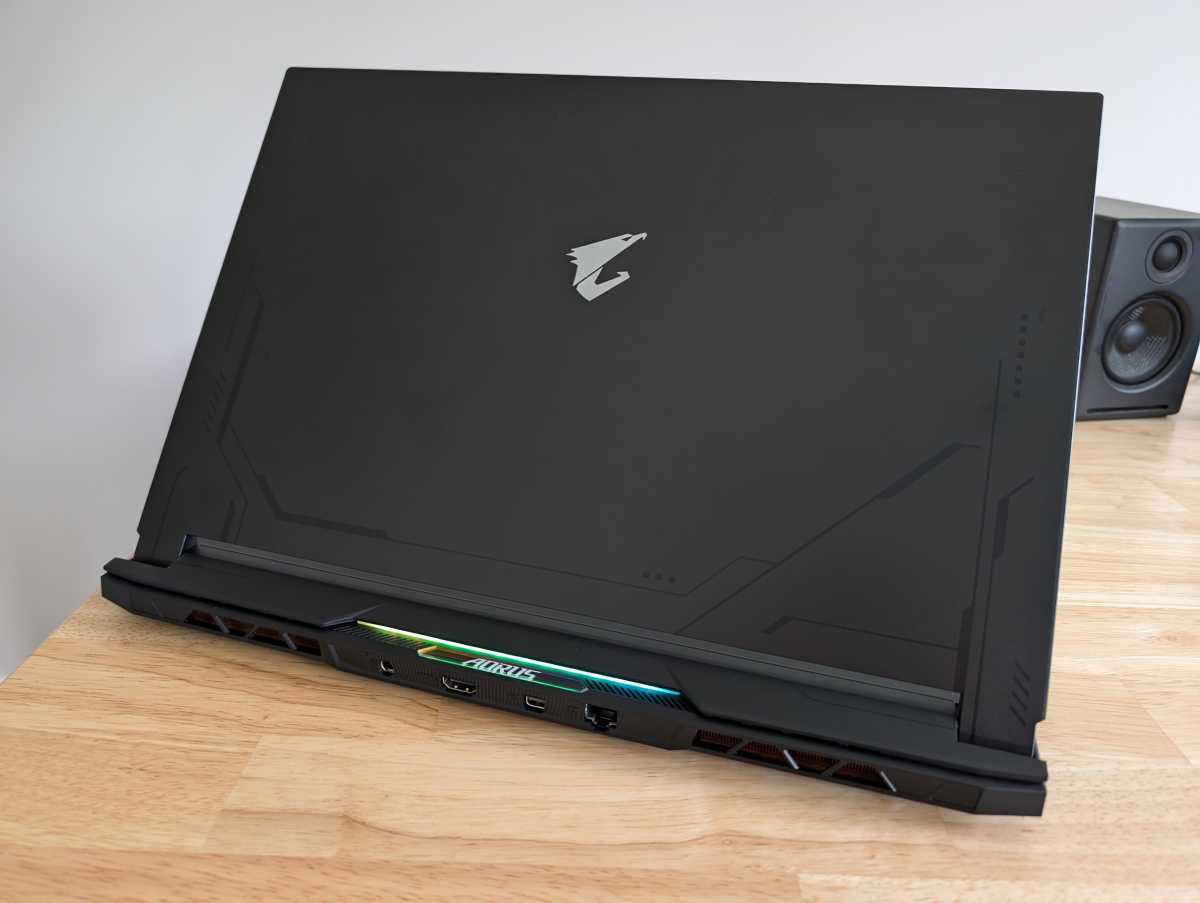
IDG / Chris Hoffman
The Gigabyte Aorus 17X packs a 17.3-inch display into a sleek-for-the-size all-black metal chassis. There’s a splash of color on the back with an “RGB Fusion Light Bar” that syncs to the keyboard’s customizable lighting. Out of the box, the keyboard’s RGB lighting animates, shifting between the different colors of the gaming LED rainbow, but they’re customizable. It’s a good combination of restrained styling with classic “gamer LED” aesthetics, and of course you can turn those LEDs off – or turn them to plain white – if you aren’t looking for the rainbow LED look.
With top-end Intel Core i9 HX CPU and Nvidia GeForce RTX 4090 graphics, I enjoyed incredibly smooth game play when playing Cyberpunk 2077: Phantom Liberty and cranking all the ray tracing settings up to their maximum.
Aside from the colorful LEDs, the laptop’s design is reasonably restrained. The Aorus bird-head design appears faintly on the touchpad, and in the form of a silver logo on the laptop’s lid.
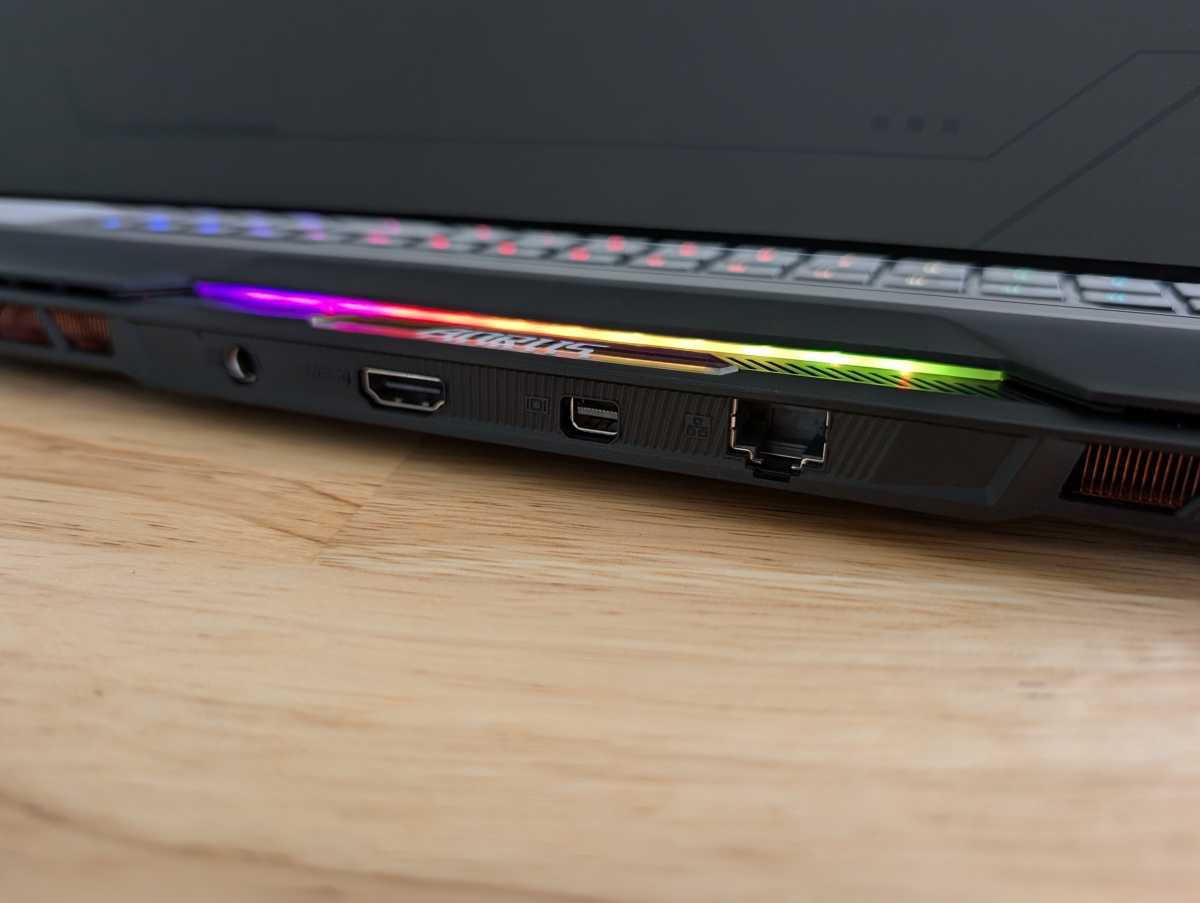
IDG / Chris Hoffman
The build quality is good for a laptop of this type. It’s on the heavy side for a laptop at over six pounds, and that’s not counting the big power brick a gaming laptop of this type requires. You will want to pick it up with two hands. That said, the laptop is lightweight and compact considering its incredibly powerful internals. The laptop’s chassis doesn’t have any weird flex to it. The display’s hinge opens easily with one hand – helped by the laptop’s weight.
My only real complaint about the design is the position of the exhaust fans. Let’s talk about those fans: They’re extremely effective. The laptop’s cooling system works very well, and it even keeps the keyboard fairly cool to the touch while gaming. But, while gaming, the laptop’s fans blast hot air out of the vents on the left and right sides of the laptop in addition to the back. Those side fans are very powerful, and they blow hard. That means your mouse hand will be getting a blast of hot air. Personally, I prefer to see a gaming laptop vent hot air out of the back so it doesn’t blow on my hand. Of course, it’s not too hard to reposition your mouse or re-angle the laptop to avoid this. This is a common issue with gaming laptops, but it’s something to be aware of.
Gigabyte Aorus 17X: Keyboard and trackpad
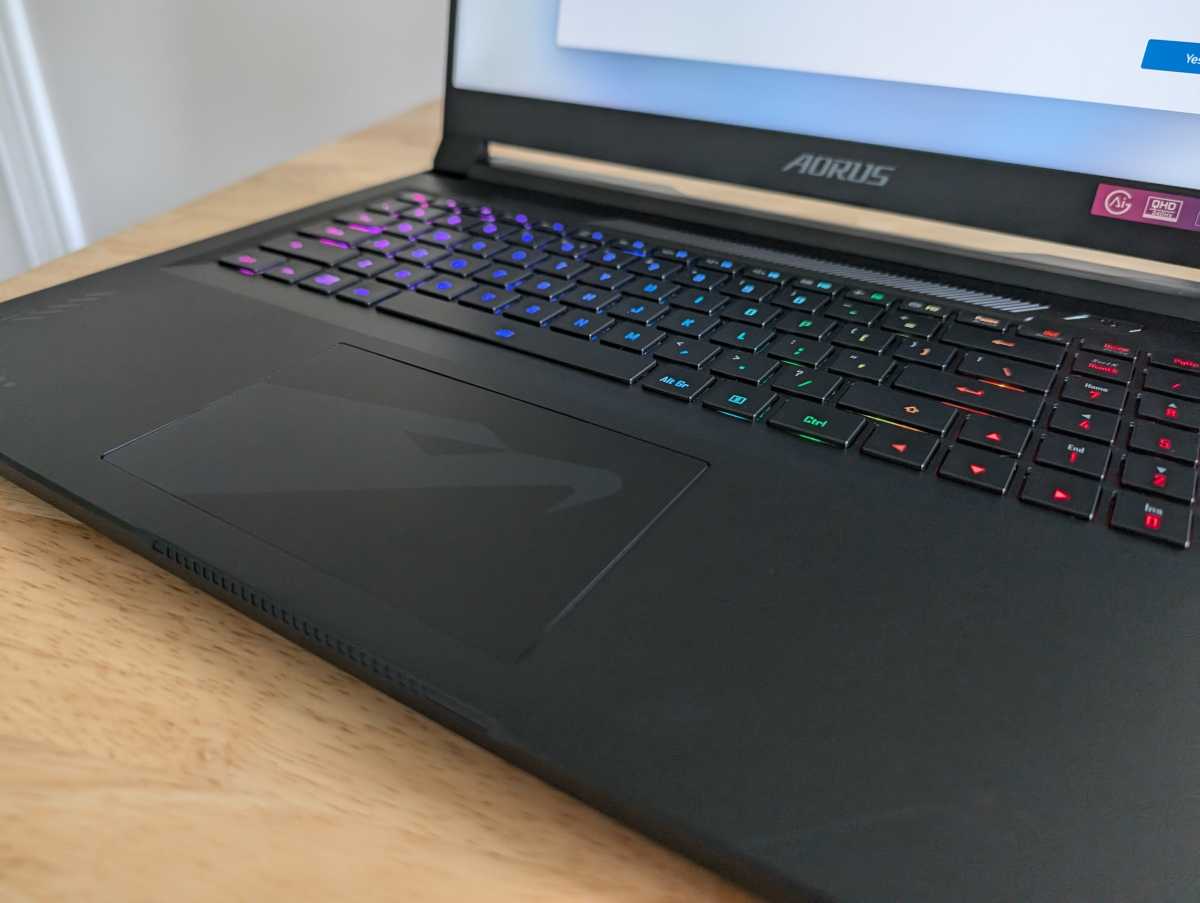
IDG / Chris Hoffman
The Gigabyte Aorus 17X delivers a great “chiclet-style” keyboard. There’s plenty of key travel – Gigabyte says it has 2.0mm of key travel – and the keyboard feels good to use, whether you’re gaming or typing up a document. Gigabyte says the keyboard supports up to 80 simultaneous key presses.
Gigabyte used the laptop’s large size to make room for a number pad at the right side of the laptop’s keyboard. That’s a feature I like to see, but your mileage may vary. (Still, with a laptop of this size, there’d be a lot of empty space on the keyboard deck if Gigabyte didn’t add that number pad.)
Each key is individually backlit, and you can customize them individually. It’s a high-quality keyboard I’m happy with. Still, since we’re talking about high-end gaming laptops with top-end hardware, it’s worth noting that many people prefer mechanical keyboards – and some other high-end gaming laptops offer mechanical keyboards.
The laptop’s trackpad is totally fine – smooth, responsive, and with good palm-rejection. It was great to use in a pinch, although I imagine most gamers will be using a mouse or controller for gaming.
Gigabyte Aorus 17X: Display and speakers
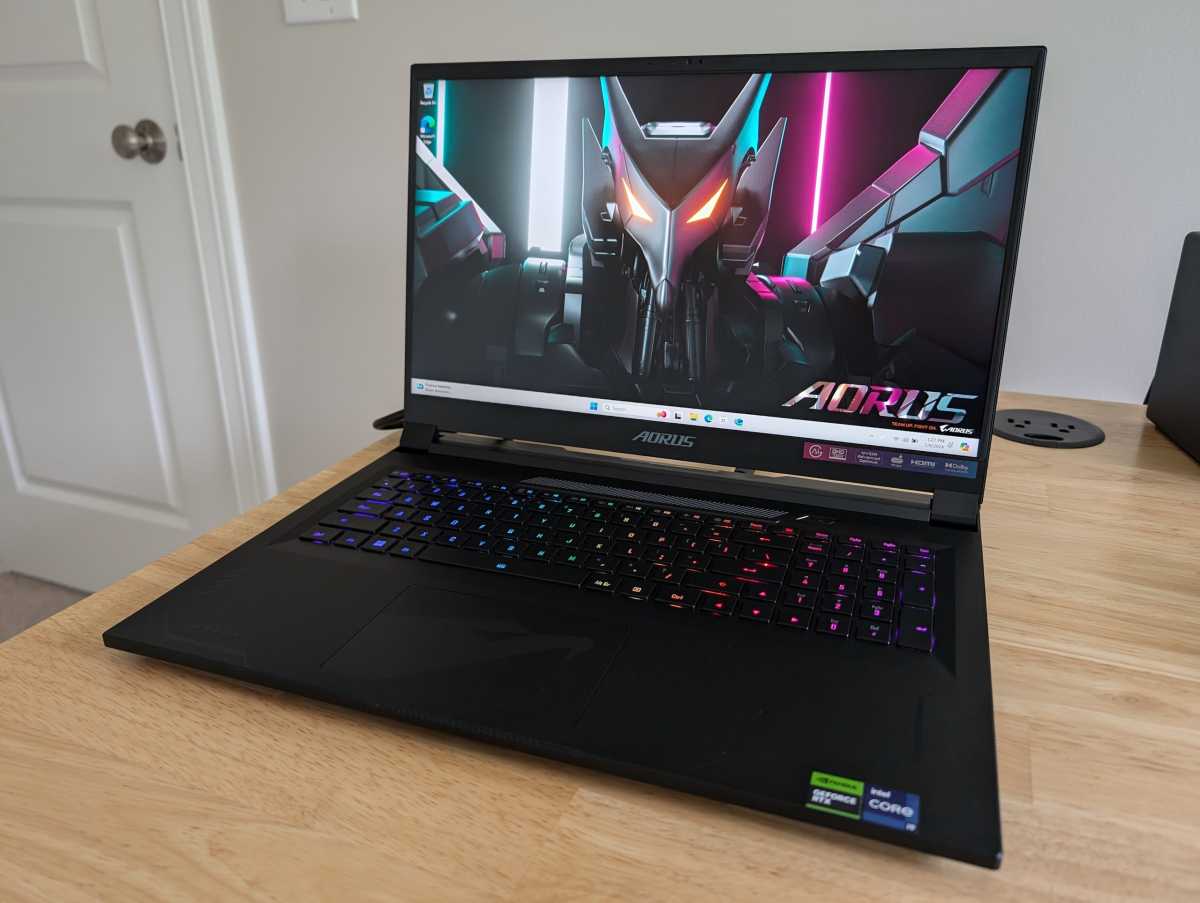
IDG / Chris Hoffman
The Gigabyte Aorus 17X offers a 17.3-inch 16:9 IPS display with a 2560×1440 resolution and 240Hz refresh rate. That’s a solid display on paper, and it looks good in the real world, too.
But the display is one place where Gigabyte cut some corners. The biggest problem: It isn’t particularly bright, with just over 300 nits of brightness. Gigabyte advertises some HDR support, but that only applies to video streaming. You won’t be able to use HDR in games. A display capable of delivering more brightness would be a real upgrade. Also, many people might prefer a more vivid OLED display on a laptop – even if that OLED screen may not be capable of delivering the same high refresh rate.
It’s a fine display, there’s no doubt about it. But the display here isn’t the “best of the best” in the same way the GPU and CPU are. It’s also worth noting that the laptop has a 16:9 display, and some people may prefer a taller 16:10 display.
The speakers here are fine. They sound standard for a gaming laptop – they’re not particularly impressive. You’ll have a better gaming experience if you use headphones or external speakers. If you want high-end integrated speakers on a laptop, they’re harder to find. The Alienware x16 R2 is a good example of a gaming laptop that can deliver a mechanical keyboard and unusually improved speakers. (Unfortunately, that Alienware laptop also has a fairly dim display.)
Gigabyte Aorus 17X: Webcam, microphone, biometrics
The 1080p webcam on the Gigabyte Aorus 17X looks fine. It’s a very standard webcam. While it won’t blow your mind, it’s much better than the lower-resolution 720p webcams I sometimes spot in less expensive gaming laptops.
The built-in microphone did not impress. For some reason, the microphone was incredibly quiet until I increased the input volume to near maximum. At near maximum, the quality did not sound particularly great. This volume issue is the same problem I had with a previous Gigabyte gaming laptop, the Aorus 16X. While this isn’t a huge deal as most gamers will likely use an external microphone, this part of the laptop experience could use some extra polish.
The IR camera on the Gigabyte Aorus 17X did a good job of signing me in with Windows Hello facial recognition in a wide variety of lighting conditions. I’m a big fan of this feature as it will sign you in as soon as you open your laptop. However, some people will prefer a fingerprint reader, and Gigabyte doesn’t offer one on this laptop.
Gigabyte Aorus 17X: Connectivity
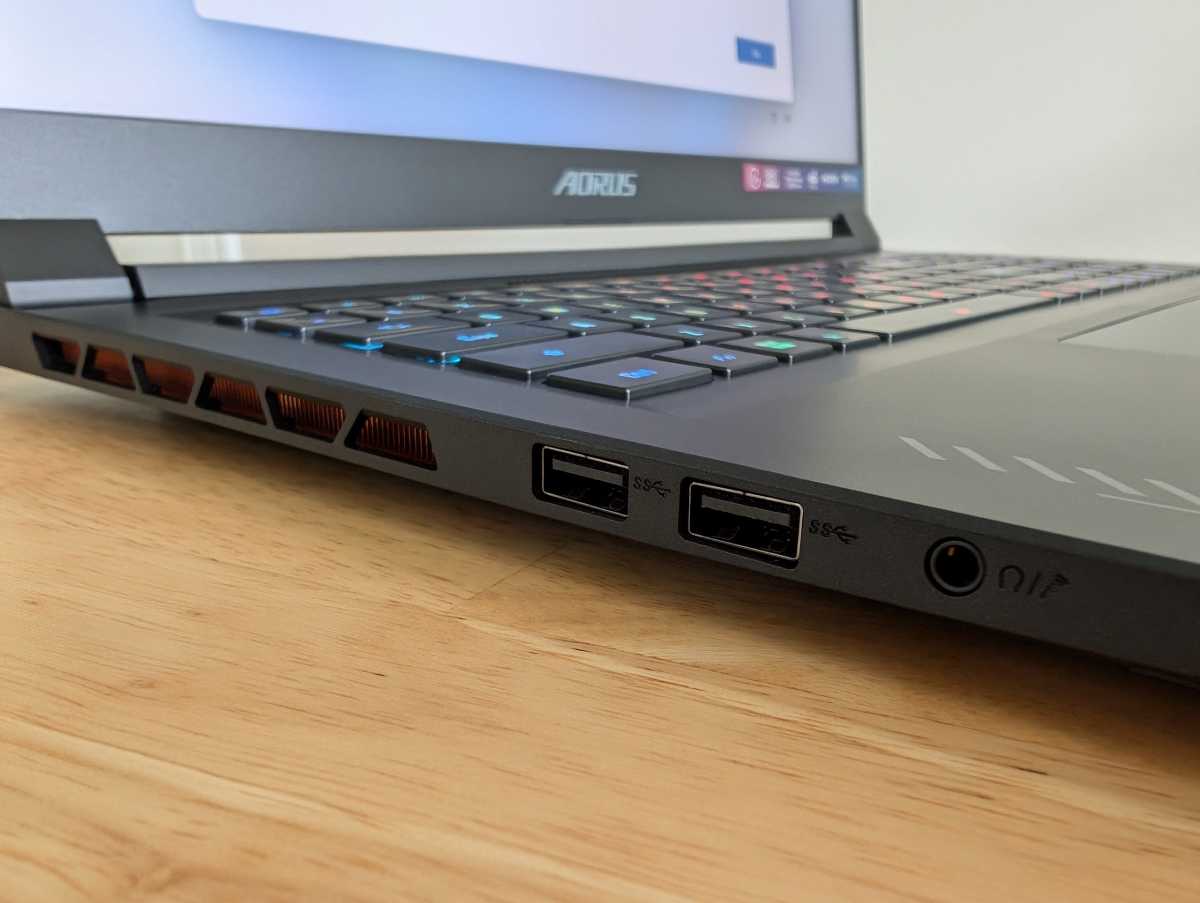
IDG / Chris Hoffman
The Gigabyte Aorus 17X delivers a variety of decent connectivity options. On the left side of the laptop, you’ve got two USB Type-A ports – both supporting USB3.2 Gen 2 – and a combo audio jack.
On the right side of the laptop, you’ve got a third USB Type-A port (USB 3.2 Gen 2) along with a single USB Type-C port that supports Thunderbolt 4 as well as USB4 with DisplayPort 1.4 and Power Delivery 3.0.
On the back of the laptop, you’ll find a HDMI 2.1 output port, Mini DisplayPort 1.4 port, 2.5 gigabit RJ-45 Ethernet jack, and DC power in jack. That’s a good collection of ports, although you aren’t getting any sort of SD card reader here – and there’s just the one USB Type-C port.
This laptop also has Wi-Fi 6E and Bluetooth 5.2 wireless hardware. The Wi-Fi performed well, with a strong and reliable signal. However, now that we’re getting into mid-to-late 2024, it would be good to start seeing Wi-Fi 7 on laptops – especially ones that are this expensive.
Gigabyte Aorus 17X: Performance
The Gigabyte Aorus 17X delivered great performance thanks to its powerful hardware. With top-end Intel Core i9 HX CPU and Nvidia GeForce RTX 4090 graphics, I enjoyed incredibly smooth game play when playing Cyberpunk 2077: Phantom Liberty and cranking all the ray tracing settings up to their maximum.
But the benchmarks will tell the full tale. As always, we ran the Gigabyte Aorus 17X through our standard benchmarks to see how it performs.
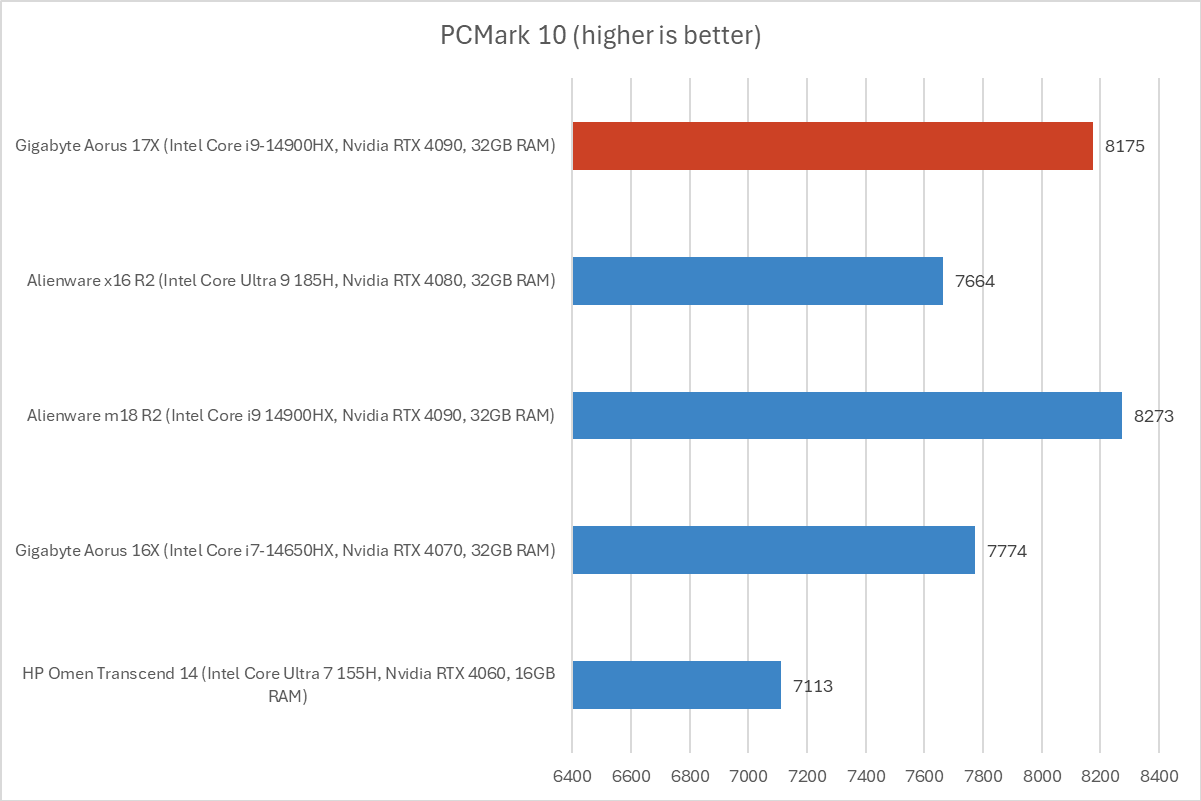
IDG / Chris Hoffman
First, we run PCMark 10 to get an idea of overall system performance. While it’s an overall system benchmark, it’s particularly focused on CPU performance.
The Gigabyte Aorus 17X delivered an average PCMark 10 overall score of 8175, ahead of all the competing laptops aside from the 18-inch Alienware m18 R2, which has the same CPU and GPU. That’s a substantially larger and heavier laptop, so it’s no surprise that it has a bit of a performance edge – it’s likely able to cool the internals better.
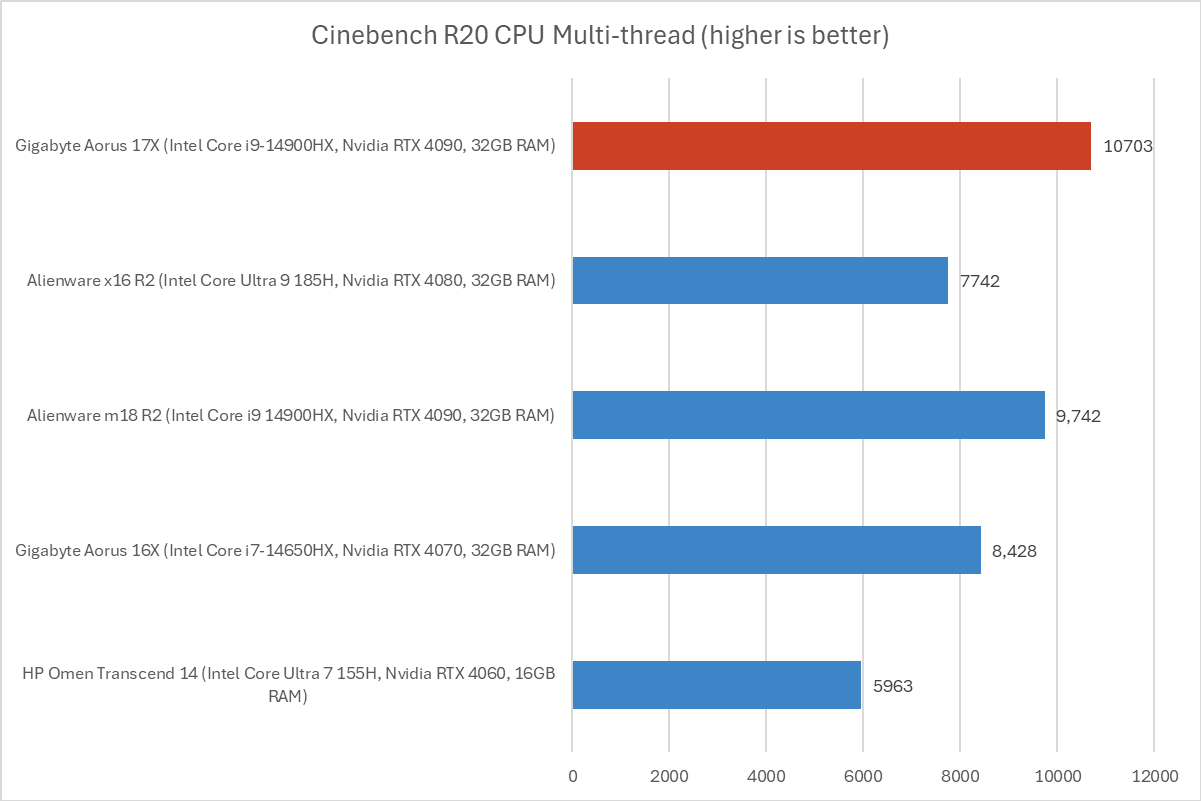
IDG / Chris Hoffman
Next, we run Cinebench R20. This is a heavily multithreaded benchmark that focuses on overall CPU performance. It’s a quick benchmark, so cooling under extended workloads isn’t a factor. But, since it’s heavily multithreaded, CPUs with more cores have a huge advantage.
This laptop scored an average of 10703 on the multithreaded Cinebench 20 benchmark. That’s surprising as it comes out ahead of the Alienware m18 R2. This laptop is no slouch when it comes to CPU performance, thanks to that Intel Core i9 CPU.
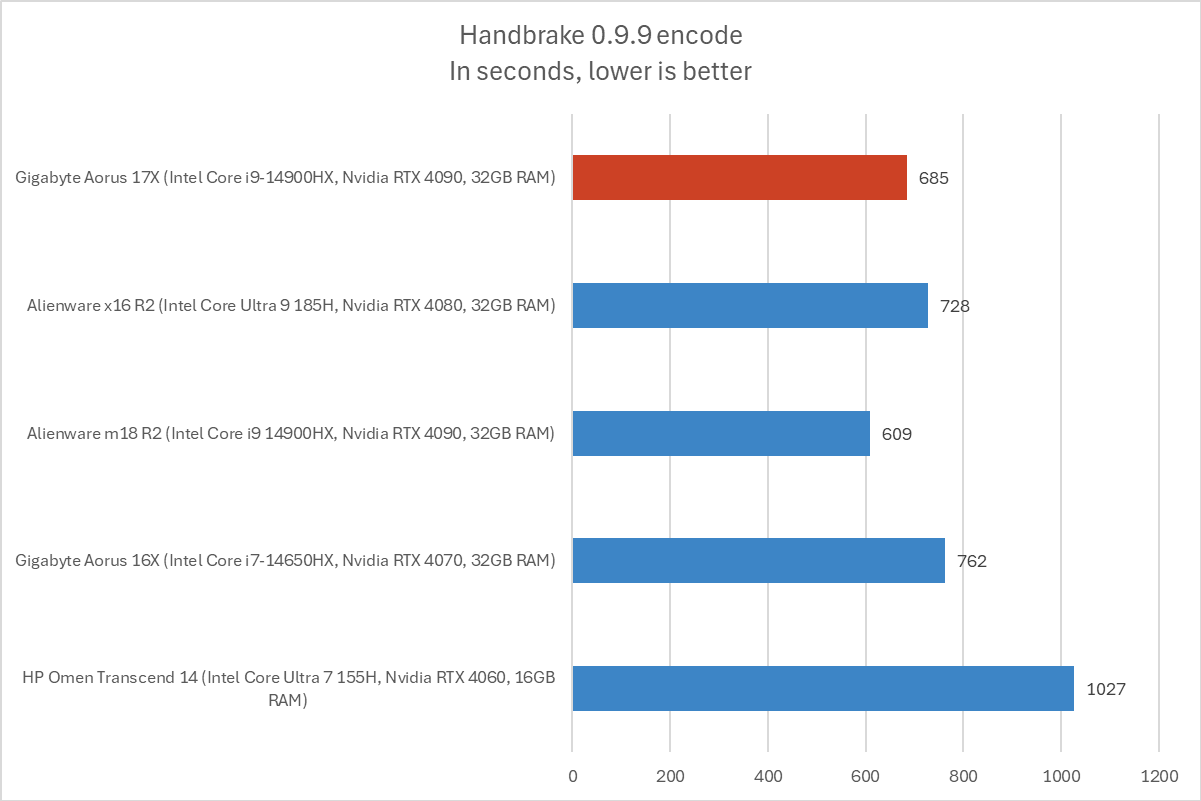
IDG / Chris Hoffman
We also run an encode with Handbrake. This is another heavily multithreaded benchmark, but it runs over an extended period. This demands the laptop’s cooling kick in, and many laptops will throttle and slow down under load.
The Gigabyte Aorus 17X completed the encode process in 685 seconds – that’s about eleven and a half minutes. Once again, it’s a little slower than that monstrous 18-inch Alienware machine, but ahead of all the other laptops we’re comparing it to.

IDG / Chris Hoffman
Next, we run a graphical benchmark. As a gaming laptop, these are the most important benchmarks to get an idea of real-world gaming performance. We run 3Dmark Time Spy, a graphical benchmark that focuses on GPU performance.
With an average score of 19342 in the benchmark, the GeForce 4090-equipped Gigabyte Aorus 17X was once again ahead of every other laptop except that 18-inch Alienware rig.
After that, we run the benchmarks built into some games. First, we use the built-in benchmark in Shadow of the Tomb Raider to test all the gaming laptops we review. It’s an older game, but it’s a great way to compare graphical performance across different PCs.
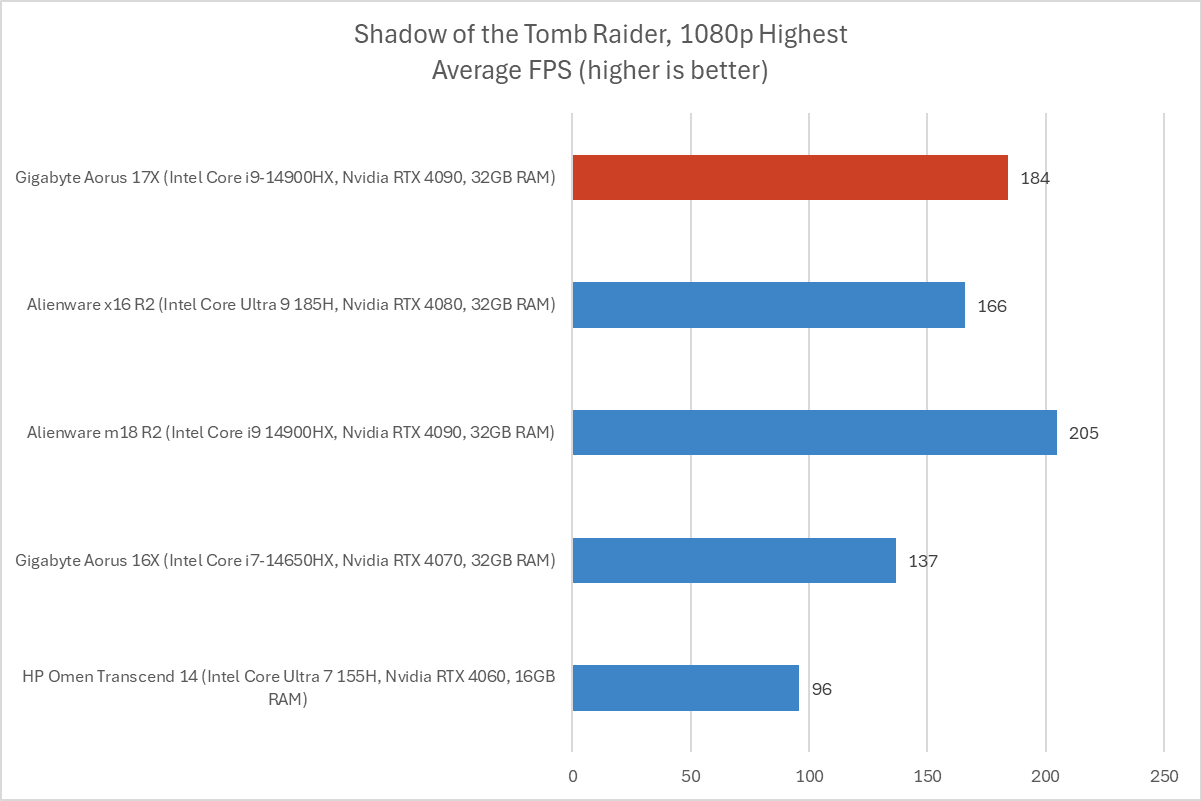
IDG / Chris Hoffman
The Gigabyte Aorus 17X delivered an average frames per second of 184 in the benchmark. That’s faster than other laptops with slower GPUs. However, it does come up short compared to Alienware’s 18-inch gaming monster once again.
Finally, we run the built-in benchmark in Metro Exodus. This is a more demanding game, and we set the benchmark to 1080p resolution at the Extreme detail setting.
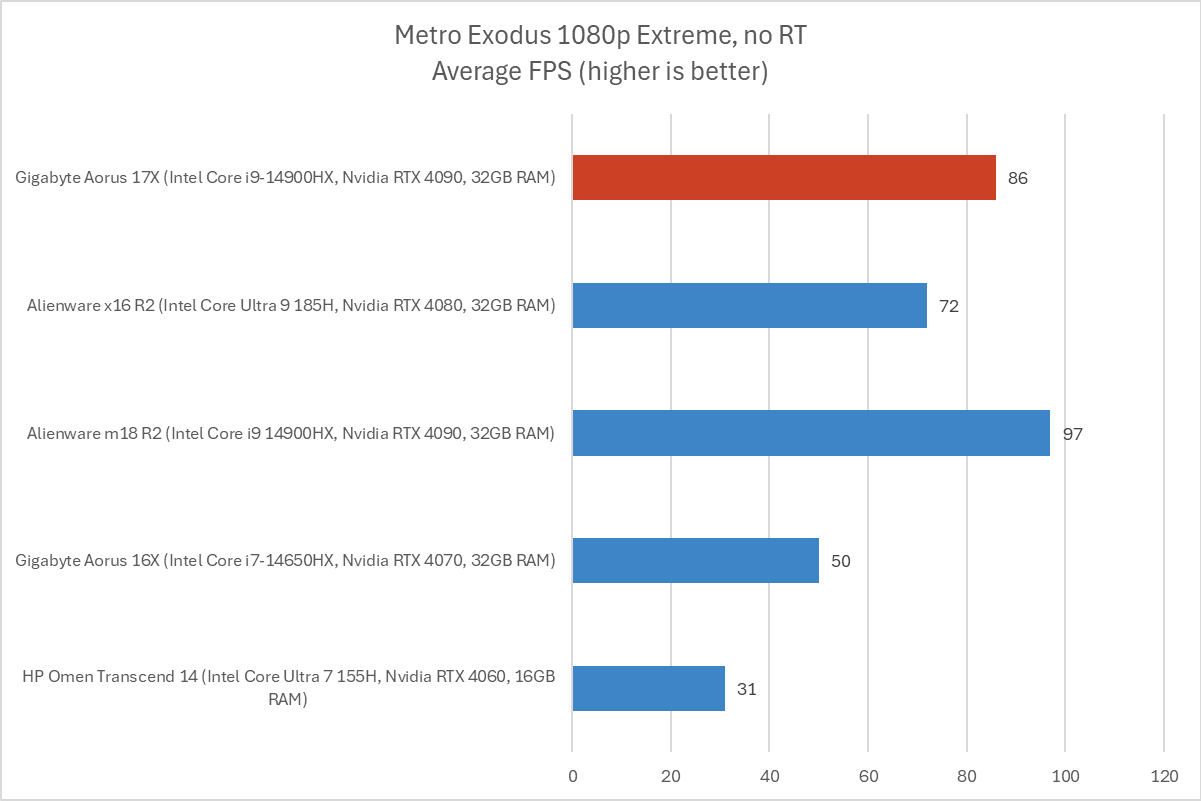
IDG / Chris Hoffman
The Gigabyte Aorus 17X ran the benchmark at an average of 86 FPS. Once again, that’s noticeably slower than Alienware’s beefy 18-inch rig but faster than every other laptop with a lower-tier GPU.
Overall, the Gigabyte Aorus 17X delivers great performance. But the results show us that the CPU and GPU in a computer aren’t all that matters for performance. Cooling is an especially important factor. But it’s no surprise that the Alienware m18 R2 won the comparison on performance alone: That much larger machine is 9.32 pounds, while the Aorus is 6.17 pounds.
Gigabyte Aorus 17X: Battery life
Gaming laptops aren’t known for their long battery life – especially not 17-inch gaming laptops like the Gigabyte Aorus 17X. Still, this laptop boasts a 99 Watt-hour battery, which is the biggest the battery can get and still be allowed on an airplane under U.S. Transportation Security Administration rules.

IDG / Chris Hoffman
To benchmark the battery life, we play a 4K copy of Tears of Steel on repeat in the Movies & TV app on Windows 11 with airplane mode enabled and the keyboard backlight turned off until the laptop suspends itself. We set the screen to 250 nits of brightness for our battery benchmarks. This is a best-case scenario for any laptop since local video playback is so efficient, and real battery life in day-to-day use is always going to be less than this.
The Gigabyte Aorus 17X clocked in at an average of 348 minutes before suspending itself. That’s nearly six hours. It’s a substantially better score than that 18-inch Alienware m18 R2, which lasted about four and a half hours.
This isn’t the kind of machine you get if long battery life is a priority. However, thanks to the huge battery Gigabyte included, you should be able to use it for a few hours away from an outlet. (Bear in mind that it won’t deliver great gaming performance while it’s not plugged in. Gaming laptops are designed to play games while plugged in.)
Gigabyte Aorus 17X: Conclusion
The Gigabyte Aorus 17X is a great gaming laptop with excellent performance. This is top-of-the-line internal hardware in a chassis with great build quality and a surprisingly sleep design. Of course, this 17-inch, just-over-six-pounds gaming laptop doesn’t perform quite as well as an 18-inch gaming laptop that’s over nine pounds in weight. But both of those laptops won’t perform as well as a high-end desktop PC, either. Portability is a spectrum.
The display gives me the most pause here. This laptop costs about $3,700 at full retail price, and the screen only offers about 300 to 400 nits of brightness. Many people will prefer a brighter screen. In fact, many people may prefer the more vivid picture on an OLED screen if they’re looking to spend nearly $4,000 on a laptop.
If you want a 17-inch gaming laptop with top-of-the-line hardware and you find the Gigabyte Aorus 17X at a good price compared to the competition, it’s a nice laptop. I just wish it had a better, brighter display, as that would make it easier to recommend.


